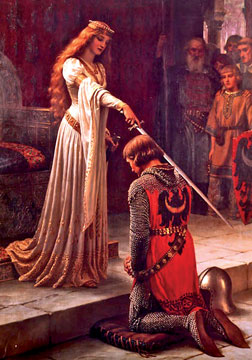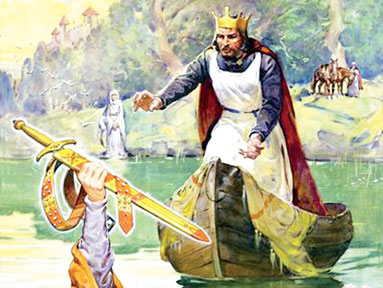|
Chretien de Troyes:
French medieval romances and Arthurian legends
Romance to realism and beyond
By Modelsis wighnes
Chretien de Troyes wrote in Champagne, France during the third
quarter of the twelfth century. He lived between 1160 and 1172 in the
court of his patroness, the Countess Marie de Champagne. She was the
daughter of Louis VII and of Eleanor of Aquitaine, (who moved from the
South of France in 1137 to Paris and then to England). She possessed her
royal mother's tastes and made her court a social experiment. The old
city of Troyes, where she held her court, often appears in a map of
literary history.
 |
|
Arthurian Legend |
It was there that Chretien wrote four romances which together form
the most complete expression of the ideals of French chivalry from a
single author. These romances are written in eight-syllable rhyming
couplets. Another poem, "Perceval le Gallois", was composed about 1175
for Philip, Count of Flanders, to whom Chretien was attached during his
last years. This last poem is not included in the present translation
because of its extraordinary length of 32,000 verses, because Chretien
wrote only the first 9000 verses, and there is an English version of
Wolfram's wellknown "Parzival", which tells the same story, though in a
different spirit. The romance of "Lancelot" was not completed by
Chretien but the poem is his in such large part that one would be
over-scrupulous not to call it his.
Pious romance
In addition, there are quite generally assigned to the poet two
insignificant lyrics, the pious romance of "Guillaume d'Angleterre", and
the elaboration of an episode from Ovid's "Metamorphoses" called
"Philomena" by its most recent editor (Paris 1909). All these are extant
and accessible.
However, since "Guillaume d'Angleterre" and "Philomena" are not
universally attributed to Chretien, and since they have nothing to do
with the Arthurian material, it seems reasonable to limit the present
enterprise to "Erec and Enide", "Cliges", "Yvain", and "Lancelot".
Some critics, basing their remarks upon the best knowledge we have,
have called "Erec and Enide" the oldest Arthurian romance extant.
Scholarship has shown that from the early Middle Ages popular tradition
was alive in Britain and Brittany. The existence of these traditions
common to the Brythonic peoples was called to the attention of the
literary world by William of Malmesbury and Geoffrey of Monmouth in
their Latin histories about 1125 and 1137 respectively, and by the
Anglo-Norman poet Wace immediately afterward. Scholars have waged war
over the theories of transmission of the so-called Arthurian material
during the centuries which elapsed between the time of the fabled
chieftain's activity in 500 A.D. and his appearance as a great literary
personage in the twelfth century.
There are not many documents available for the dark ages of popular
tradition before the Norman Conquest. However, Arthur and his knights,
as we see them in the earliest French romances, have little in common
with their Celtic prototypes, as we dimly catch sight of them in Irish,
Welsh, and Breton legend. Chretien belonged to a generation of French
poets who took over a large portion of the Celtic folk-lore they
imperfectly understood and produced what had never been before. This
then became the vehicle to carry a rich freight of chivalric customs and
ideals.
As an ideal of social conduct, the code of chivalry never touched the
middle and lower classes, yet it was the religion of the 12th Century
aristocracy. Never was literature in any age closer to the ideals of a
social class. This is so much the case that it is difficult to determine
whether social practices called forth the literature, or whether, as in
the case of the seventeenth-century pastoral romance in France, it is
truer to say that literature suggested to society its ideals. For the
glaring inconsistencies between the reality and the ideal, we may turn
to the chronicles of the period. Yet, even history tells of many an ugly
act rebuked and of many a gallant deed performed because of the
courteous ideals of chivalry. The debt of our own social code to this
literature of courtesy and frequent self-sacrifice is manifest.
Source
What Chretien's immediate and specific source was for his romances is
of great interest. Unfortunately, he has left us in doubt because he
speaks in the vaguest way of the materials he used.
There is no evidence that he had any Celtic written source. We are
thrown back upon Latin or French literary originals which are lost, or
upon current continental lore going back to a Celtic source.
This very difficult problem is as yet unsolved in the case of
Chretien, as it is in the case of the Anglo-Norman Beroul, who wrote of
Tristan about 1150. The material evidently was at hand and Chretien
appropriated it, without much understanding of its primitive spirit, but
appreciating it as a setting for the ideal society dreamed of but not
realised in his own day.
A French narrative poet of the twelfth century had three categories
of subject-matter from which to choose: legends connected with the
history of France ("matiere de France"), legends connected with Arthur
and other Celtic heroes ("matiere de Bretagne"), and stories culled from
the history or mythology of Greece and Rome, current in Latin and French
translations ("matiere de Rome la grant"). Chretien tells us in "Cliges"
that his first essays as a poet were the translations into French of
certain parts of Ovid's most popular works. Yet he appears early to have
chosen as his special field the stories of Celtic origin dealing with
Arthur, the Round Table, and other features of Celtic folk-lore. Not
only was he alive to the literary interest of this material when adapted
to suit the taste of French readers, but he gave to rather crude
folk-lore the polish and elegance which is peculiarly French, and which
is inseparably associated with the Arthurtan legends in all modern
literature.
Romantic poems
Though Beroul, and perhaps other poets, had previously based romantic
poems upon individual Celtic heroes like Tristan, to Chretien, is due
the considerable honour of having constituted Arthur's court as a
literary centre and rallying- point for an innumerable company of
knights and ladies engaged in a never-ending series of amorous
adventures and dangerous quests. Rather than attribute to Chretien this
important literary convention, we should bear in mind that all his poems
imply familiarity on the part of his readers with the heroes of the
court of which he speaks. One would suppose that other stories, told
before his versions, were current. Some critics would go so far as to
maintain that Chretien came toward the close, rather than at the
beginning, of a school of French writers of Arthurian romances. But, if
so, we do not possess these earlier versions, and for lack of rivals
Chretien may be hailed as an innovator in the current schools of poetry.
 |
|
King Arthur |
Chretian's style is typical of all medieval narrative literature. The
pastimes of this class of readers that it was aimed at were jousting,
hunting, and making love. However, it is certain that Chretien intended
to avoid what was indecent, as did the writers of narrative poetry in
general. To appreciate fully the chaste treatment of Chretien, one must
know some other forms of medieval literature, such as the fabliaux,
farces, and morality plays, in which courtesy imposed no restraint.
These will be examined in later columns.
With regard to Chretien's use of his sources, many critics have
minimised the French poet's originality by pointing out striking
analogies in classic and Celtic fable.
The difficult point to determine, in speaking of conceptions so
widespread in classic and medieval literature, is the immediate source
of Chretien's influences. Critics disagree over so-called Anglo-Norman
theory which supposes the existence of lost Anglo-Norman romances in
French as the sources of Chretien de Troyes, is, nevertheless, well
within the truth when he insists upon what is, so far as we are
concerned, the essential originality of the French poet. The general
reader today will care as little as did the reader of the twelfth
century how the poet came upon the motives and episodes of his stories,
whether he borrowed them or invented them himself.
Chronology
Scholars have sought to fix the chronology of the poet's works, and
have been tempted to speculate upon the evolution of his literary and
moral ideas. When we speculate upon the development of Chretien's moral
ideas we are not on such sure ground. His standards vary widely in the
different romances. How much of this variation is due to chance
circumstance imposed by the nature of his subject or by the taste of his
public, and how much to changing conviction it is easy to see, when we
consider some contemporary novelist, how dangerous it is to judge of
moral convictions as reflected in literary work.
"Erec" is the oldest Arthurin romance to have survived in any
language, but it is almost certainly not the first to have been written.
It is a story of love, estrangement, and reconciliation in the persons
of Erec and his charming sweetheart Enide. The psychological analysis of
Erec's motives in the rude testing of Enide is worthy of attention, and
is more subtle than anything previous in French literature with which we
are acquainted. The poem is an episodic romance in the biography of an
Arthurinn hero, with the usual amount of space given to his adventures.
"Cliges" apparently connects a Byzantine tale of doubtful origin in an
arbitrary fashion with the court of Arthur. It is thought that the story
embodies the same motive as the widespread tale of the deception
practised upon Solomon by his wife, and that Chretien's source, as he
himself claims, was literary.
The scene where Fenice feigns death in order to rejoin her lover is a
parallel of many others in literary history, and will, of course,
suggest the situation in Romeo and Juliet.
Epic poems
In the oldest epic poems we find only God- fearing men and a few
self-effacing women; in the Arthurian romances we meet gentlemen and
ladies, more elegant and seductive than any one in the epic poems, but
less fortified by faith and sense of duty against vice because breathing
an enervating atmosphere of leisure and decadent morally.
The student of the history of social and moral ideals will find much
to interest him in Chretien's romances.
Medieval references show that he was held by his immediate
successors, as he is held to-day when fairly viewed, to have been a
master of the art of story-telling. Chretien spreaks through the ages
for himself and his generation.
He is to be read as a story-teller rather than as a poet, as a
casuist rather than as a philosopher. However his significance as a
literary artist and as the founder of a precious literary tradition
distinguishes him from all other poets of the Latin races between the
close of the Empire and the arrival of Dante.
|

